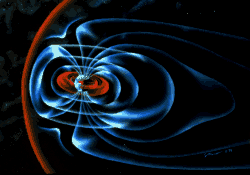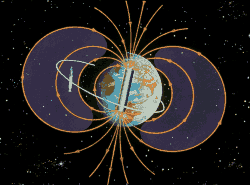|
|
Planet Earth:
a great magnet
 |
| |
An artists conception
of the Earth's magnetosphere.
Image credit: Space
Science Institute. Artwork
by Steve
Mercer. |
|
Our planet is a giant magnet. You prove this
each time you use a compass, but beyond that you
probably don't notice it much. You may not
think of
magnetism at all while viewing an aurora,
the beautiful light show of polar skies. Or when your AM radio won't tune in,
or when your power won't turn on. But all these things are affected by Earth's
magnetic field.
Earth's invisible magnetic field extends far out into space to form a region
we call the magnetosphere. The force of the solar
wind pushes on the magnetosphere, squeezing in the Sunward side and stretching
the night side into a long tail (called the magetotail) that extends hundreds
of thousands of miles into space. As the solar wind flows past the magnetosphere,
it acts like a cosmic generator, producing millions of amps of electric current.
Some of this electric current flows into Earth's upper atmosphere which can
light up like a neon tube to create the mysterious aurora (Northern and Southern
Lights).
 |
| A diagram of the Earth's magnetic field, which near
the Earth resembles that of a bar magnet. Courtesy NASA. |
There are many unique regions in and near Earth's magnetosphere: the bow shock,
magnetotail, radiation belts, and the ionosphere. Earth's magnetic field acts
like a shield to the supersonic solar wind. A shock wave (called the bow shock),
like that produced by supersonic aircraft, slows and heats the solar wind. The
magnetotail extends far away from Earth on the nightside. It is in the magnetotail,
that charged particles are energized and directed toward the polar regions where
they cause the aurora.
The First Major Discovery of the Space Age
|
 |
| The Van Allen Radiation Belts were discovered by Explorers
1 and 3 in 1958. |
Over 98% of the charged particles from the Sun and from galactic cosmic rays
that strike Earth's magnetosphere are deflected by it! The Van Allen Radiation
Belts -- two doughnut shaped belts that surround the Earth -- trap the rest of
the harmful particles, which bounce back and forth along magnetic field lines
between Earth's north and south magnetic poles like
beads on a wire.
In the upper part of Earth's atmosphere, right at the edge of Electric Space,
lies a charged layer of plasma and neutral gases called the ionosphere. It
extends from 50 to 300 miles above the surface of Earth. Here, ultraviolet rays
from the Sun and high-energy particles from outer space bombard the gases of
our atmosphere. They collide with the atoms, knocking off electrons and leaving
the positively charged nuclei--called ions--floating free. Because of these
free-floating charged particles, the ionosphere can conduct electricity. During
disturbed conditions, huge currents can flow which cause Earth's most spectacular
light show: the aurora.
SPACE STORMS
Earth's magnetosphere is very sensitive to space weather. During the Sun's
most active periods, solar wind disturbances, created by coronal
mass ejections and flares, buffet
Earth's magnetosphere and they can produce large magnetic
storms lasting one or more days. Magnetic storms have been known to seriously
damage electric power networks, affect communications, and damage satellites
orbiting near Earth.
|
|
|

